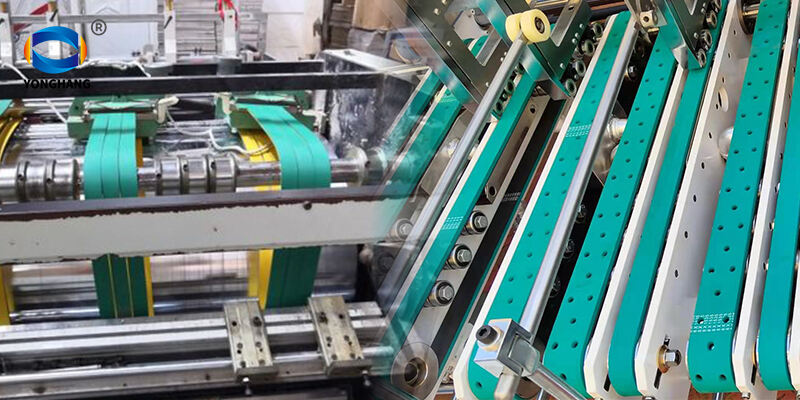How Folder Gluer Belts Impact Packaging Speed and Throughput
Understanding the role of folder gluer belts in high-speed operations
Folder Gluer Belts — serving as the key link between machine elements and packaging substrates, are in fact equivalent to setting the destiny of operating velocity and reliability. Applications are high-speed folding processes performed at speeds of more than 400 meters/minute that require accurate material placement as cardboard is transported through pre-breaking, gluing or compression stages. The surface texture and high tensile strength of Iggesund's Invercote product stop them from slipping during the fast acceleration/de-celeration cycles which are a common bottleneck in the production of crash-lock boxes. As an example, trials by a high-volume pharmaceutical packaging company of polyurethane belts with micro-grooved surfaces led to 30% lower jam rates (2024 Flexographic Industry Study).
Key performance metrics influenced by belt efficiency
Belt performance directly impacts three critical KPIs in packaging operations:
- Throughput rates: Belts with <2% elongation under load maintain consistent speed-to-compression timing, critical for achieving 95%+ equipment effectiveness (OEE).
- Glue placement accuracy: Synchronized belt movements ensure ±0.3mm positional accuracy for adhesive application nozzles.
- Reject reduction: Anti-static belt materials decrease misaligned folds by 40% in e-flute box production (2023 Packaging Operations Report).
Modern designs integrate real-time tension monitoring to balance these metrics, with leading facilities reporting 18% faster cycle times after upgrading to composite-fiber belts.
Machine design considerations for optimal belt integration
Effective belt integration requires coordinated engineering across four subsystems:
- Drive train geometry: Dual-servo pulley configurations compensate for inertial forces during speed changes.
- Guide rail spacing: Maintains 0.5-1.5mm clearance to prevent edge wear on 350gsm+ board stocks.
- Modular mounting systems: Allow rapid belt changes in <15 minutes for multi-SKU environments.
- Thermal compensation: Steel-reinforced cores prevent dimensional changes in variable humidity conditions.
Leading manufacturers have reduced changeover times by 50% through optimized belt paths that accommodate both straight-line and 6-corner box formats without rethreading.
The critical function of belts and guides in folder-gluer performance
Folder gluer belts and precision guides keep the boards true for folding and gluing phases in high-speed packaging operations. With a variance of ≤0.5 mm, the application head is precisely positioned and more than 120 boxes per minute fall off in the packaging unit due to faulty adhesive application. During high-velocity pick-and-place transfers, guides maintain lateral position and the synchronous belt movement insures consistent seam overlaps for structural strength.
Precision alignment techniques to minimize downtime
Three proven strategies enhance alignment accuracy:
- Laser-guided calibration tools detect angular deviations below 0.1°.
- Modular guide systems allow micro-adjustments without full disassembly.
- Thermal compensation protocols counter metal expansion during continuous runs.
Weekly verification cycles reduce alignment-related stoppages by 40% in typical operations (Packaging World 2023).
Case study: Achieving a 23% speed increase through guide realignment
A European corrugated manufacturer eliminated chronic jams by implementing these adjustments:
| Adjustment | Before | After |
|---|---|---|
| Guide parallelism | ±1.2mm | ±0.3mm |
| Belt tracking variance | 4mm/m | 1.5mm/m |
| Average daily output | 18,500 units | 22,800 units |
The $58,000 retrofit paid back in 11 months through reduced waste and overtime costs.
Smart sensors and real-time monitoring for accurate belt positioning
Piezoelectric sensors are embedded in the guide rails of today's systems, constantly emitting positional data which is captured by machine controls as quickly as every 5 milliseconds. This enables automatic compensation for differences in substrate thickness, belt wear patterns, and fluctuations of ambient humidity. When combined with self-learning algorithms, these systems consistently retain best-fit alignment parameters for product changeovers and have delivered 99.3 % first-pass yields in test environments.
Preventive Maintenance Strategies for Folder Gluer Belts
Folder gluer belts directly influence production continuity, with 62% of unplanned downtime in packaging lines traced to poorly maintained belt systems (Packaging Tech Journal 2023).
Reducing Micro-Stoppages With Consistent Belt Maintenance
Micro-stoppages — pauses under 3 minutes — account for 18% of annual productivity loss in high-speed packaging operations. Daily inspections of belt surfaces, combined with solvent-free cleaning, reduce these interruptions by 40%. Facilities adopting biweekly pulley groove cleaning reported 22% fewer unplanned stops over six months.
Selecting Material-Compatible Belts to Prevent Premature Wear
Belt composition must align with substrate coatings and operating temperatures. Polyurethane belts degrade faster when handling UV-cured inks, while silicone-based belts lose traction on uncoated stock. A 2022 study found mismatched materials accelerate wear rates by 300%.
Implementing Scheduled Replacement Based on Operational Load
High-speed lines processing 20,000+ boxes/hour require belt replacements every 8-12 weeks. Track belt elongation using laser gauges — replacements should occur when stretch exceeds 3% of original length. One corrugated plant avoided $740k in downtime costs (Ponemon 2023) by aligning replacement cycles with seasonal production peaks.
Reactive vs. Predictive Maintenance: Best Practices for High-Speed Environments
Predictive systems using vibration sensors and thermal imaging detect bearing wear or tension loss 72 hours before failure. A global packaging firm reduced belt-related downtime by 55% after installing IoT-enabled strain gauges.
Data Insight: Predictive Analytics Reduce Belt Failures by 30%
Facilities leveraging machine learning to analyze historical belt performance data achieved a 30% reduction in snap failures over 18 months, extending belt life by 21% in folding carton applications.
Material Compatibility and Its Effect on Folder Gluer Belt Performance
How substrate type affects belt traction and durability
Folder gluer belts face varying traction demands based on substrate properties. Corrugated board’s irregular surface requires textured belts, while coated substrates demand smoother surfaces to avoid scratching. A 2023 material study revealed belts handling kraft paperboard sustained 40% less abrasion than those processing recycled corrugated.
Key factors influencing wear:
- Substrate surface roughness (measured in µm Ra).
- Coating adhesion properties (water-based vs. solvent-based).
- Production environment humidity levels (±15% impact on belt grip).
Matching belt composition to board weight, thickness, and coating
Modern belts use polymer blends optimized for specific board specifications:
| Board Characteristic | Belt Material Requirement | Performance Goal |
|---|---|---|
| >500 gsm weight | High-tensile polyurethane | ±0.3% elongation |
| <1.5 mm thickness | Micro-textured silicone | ±0.1 mm tracking |
| Aqueous coatings | Non-porous EPDM | 0% liquid absorption |
A 2022 tension analysis showed improper material matching causes 18-22% variance in drive synchronization.
Balancing high grip and substrate protection: An industry challenge
The pursuit of faster throughput intensifies the grip-protection paradox. A recent industry trial achieved balance using:
- Dynamic grip adjustment systems (force-controlled rollers).
- Real-time coating integrity monitoring (infrared reflectance sensors).
- Self-lubricating belt materials reducing friction coefficient by 0.15.
These adaptations enabled a 25% speed increase while maintaining <0.8% substrate rejection rates.
Fine-Tuning Folder Gluer Settings to Maximize Speed and Reliability
Adjusting Belt Tension and Drive Synchronization for Smooth Operation
Proper belt tension directly impacts performance. Leading manufacturers’ guidelines suggest:
| Tension Level | Throughput Impact | Maintenance Frequency |
|---|---|---|
| High (+15%) | 5-8% speed gains | 33% more frequent roller replacements |
| Optimal | 0% deviation | Standard 500-hour cycles |
| Low (-15%) | 12% speed loss | 50% higher splice failures |
Drive synchronization errors account for 27% of unplanned stoppages in box plants (Packaging Trends 2023).
Optimizing Vacuum and Airflow Zones for Consistent Board Movement
Air management systems prevent board flutter during high-speed transfers. Key considerations include:
- Zone segmentation: Adjust suction strength for lightweight vs. rigid board segments.
- Dynamic airflow: Variable blower speeds match production rate changes.
- Nozzle positioning: 2-3mm clearance from belts minimizes turbulence.
Case Study: 15% Throughput Improvement After Recalibrating Belt Speeds
A folding carton producer faced chronic underperformance with 350gsm stock. Post-recalibration adjustments revealed:
- Speed mismatch: Infeed belts ran 12% faster than folding section.
- Vacuum imbalance: 40% higher suction in glue application zone.
- Bounce control: Missing dampers caused 5mm board displacement.
By synchronizing belt drive ratios and reallocating airflow, the plant sustained 13,800 SPM without increasing spoilage rates.
Incremental Adjustments With Real-Time Feedback for Continuous Optimization
Embedded IoT sensors provide millisecond-level feedback on belt tracking deviations, tension variations, and substrate alignment gaps. A 2022 Packaging Digest survey showed plants using live telemetry reduced unscheduled downtime by 18% compared to manual monitoring.
FAQ
What is the main role of folder gluer belts? Folder gluer belts serve as a crucial component in high-speed packaging processes, ensuring reliable performance and accurate material placements during folding, gluing, and compression stages.
How do folder gluer belts impact throughput rates? Belts with minimal elongation maintain consistent speed and compression timing, important for achieving high equipment effectiveness.
What are common challenges in folder gluer belt maintenance? Ensuring proper material compatibility, regular inspections, and timely replacements are key challenges in maintaining efficient folder gluer belt systems.
Table of Contents
- How Folder Gluer Belts Impact Packaging Speed and Throughput
- The critical function of belts and guides in folder-gluer performance
- Precision alignment techniques to minimize downtime
- Case study: Achieving a 23% speed increase through guide realignment
- Smart sensors and real-time monitoring for accurate belt positioning
-
Preventive Maintenance Strategies for Folder Gluer Belts
- Reducing Micro-Stoppages With Consistent Belt Maintenance
- Selecting Material-Compatible Belts to Prevent Premature Wear
- Implementing Scheduled Replacement Based on Operational Load
- Reactive vs. Predictive Maintenance: Best Practices for High-Speed Environments
- Data Insight: Predictive Analytics Reduce Belt Failures by 30%
- Material Compatibility and Its Effect on Folder Gluer Belt Performance
- How substrate type affects belt traction and durability
- Matching belt composition to board weight, thickness, and coating
- Balancing high grip and substrate protection: An industry challenge
- Fine-Tuning Folder Gluer Settings to Maximize Speed and Reliability
- Adjusting Belt Tension and Drive Synchronization for Smooth Operation
- Optimizing Vacuum and Airflow Zones for Consistent Board Movement
- Case Study: 15% Throughput Improvement After Recalibrating Belt Speeds
- Incremental Adjustments With Real-Time Feedback for Continuous Optimization
- FAQ

 EN
EN
 AR
AR
 HR
HR
 DA
DA
 NL
NL
 FR
FR
 DE
DE
 EL
EL
 HI
HI
 IT
IT
 JA
JA
 KO
KO
 NO
NO
 PL
PL
 PT
PT
 RO
RO
 RU
RU
 ES
ES
 TL
TL
 IW
IW
 ID
ID
 SR
SR
 SK
SK
 UK
UK
 VI
VI
 TH
TH
 TR
TR
 AF
AF
 MS
MS
 IS
IS
 HY
HY
 AZ
AZ
 KA
KA
 BN
BN
 LA
LA
 MR
MR
 MY
MY
 KK
KK
 UZ
UZ
 KY
KY
